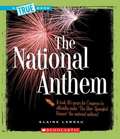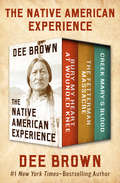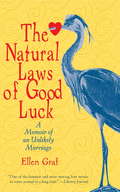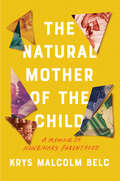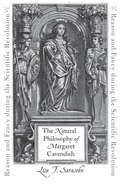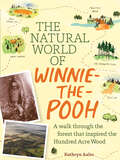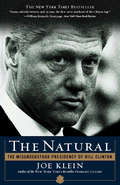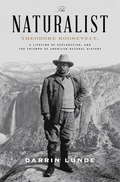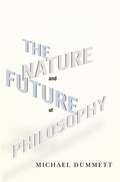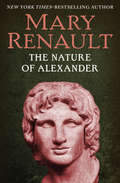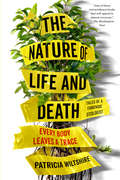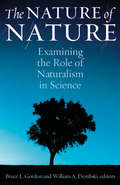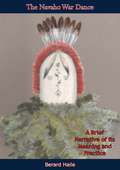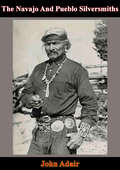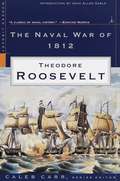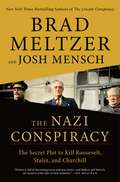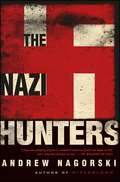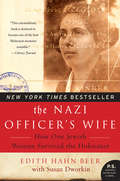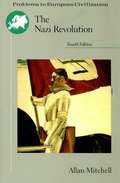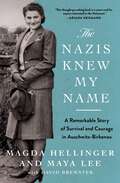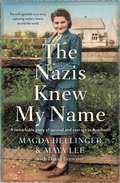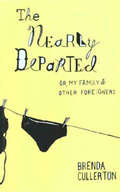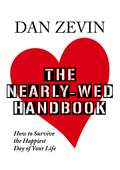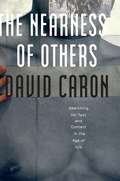- Table View
- List View
The National Anthem
by Elaine LandauIdeal for today's young investigative reader, each A True Book includes lively sidebars, a glossary and index, plus a comprehensive "To Find Out More" section listing books, organizations, and Internet sites. A staple of library collections since the 1950s, the new A True Book series is the definitive nonfiction series for elementary school readers. A True Book -- American History: How do you wrap a 450,000-pound gift? What is the world's oldest and shortest written consitution? Find out in this patriotic celebration of things uniquely American.
The Native American Experience: Bury My Heart at Wounded Knee, The Fetterman Massacre, and Creek Mary's Blood
by Dee BrownThree powerful tales from the acclaimed chronicler of the American West—including the #1 New York Times bestseller, Bury My Heart at Wounded Knee. Two profoundly moving, candid histories and a powerful novel illuminate important aspects of the Native American story. Bury My Heart at Wounded Knee: The #1 New York Times bestseller that awakened the world to the destruction of American Indians in the nineteenth-century West, Dee Brown&’s groundbreaking history focuses on the betrayals, battles, and systematic slaughter suffered by Native American tribes between 1860 and 1890, culminating in the Sioux massacre at Wounded Knee. &“Shattering, appalling, compelling . . . One wonders, reading this searing, heartbreaking book, who, indeed, were the savages&” (The Washington Post). The Fetterman Massacre: A riveting account of events leading up to the Battle of the Hundred Slain—the devastating 1866 conflict at Wyoming&’s Ft. Phil Kearney that pitted Lakota, Arapaho, and Northern Cheyenne warriors—including Oglala chief Red Cloud, against the United States cavalry under the command of Captain William Fetterman. Based on a wealth of historical resources and sparked by Brown&’s narrative genius, this is an essential look at one of the frontier&’s defining conflicts. Creek Mary&’s Blood: This New York Times bestseller fictionalizes the true story of Mary Musgrove—born in 1700 to a Creek tribal chief—and five generations of her family. The sweeping narrative spans the Revolutionary War, the Trail of Tears, and the Civil War—in which Mary&’s descendants fought on both sides of the conflict. Rich in detail and human drama, Creek Mary&’s Blood offers &“a robust, unfussed crash-course in Native American history that rolls from East to West with dark, inexorable energy&” (Kirkus Reviews).
The Natural Laws of Good Luck: A Memoir of an Unlikely Marriage
by Ellen GrafEllen is forty-six, divorced, and having no luck with personal ads when her Chinese girlfriend comes up with a plan: she has a brother in China, Zhong-hua, who's lonely too. Maybe they'd like each other? Taking a leap of faith that most of us wouldn't dare, Ellen travels to China to meet him. Though they speak only a few words of each other's language, there's an unspoken connection between them and they decide to marry.What follows is a remarkably touching and humorous story of two people from completely different worlds trying to make a marriage work. Settling in at Ellen's ramshackle farmhouse in upstate New York, they quickly discover the cultural chasm that lies between them. Ellen and her teenage daughter decide to adopt a policy of nonjudgment as Zhong-hua lobbies to sell their refrigerator ("Just three people, no need"), serves them giant sea slugs for dinner, and brusquely nudges Ellen aside without an "excuse me" ("Family no need these kind of words").Zhong-hua is not the type to offer his wife impromptu smiles or hugs, but in bed at night he holds her tightly like she's "something long lost and precious that might not live until morning." The Natural Laws of Good Luck is an unusual and exquisitely written love story--one that will resonate with anyone who has ever contemplated with wonder the spaces that exist between us and those we care about.
The Natural Mother of the Child: A Memoir of Nonbinary Parenthood
by Krys Malcolm BelcKrys Malcolm Belc's visual memoir-in-essays explores how the experience of gestational parenthood—conceiving, birthing, and breastfeeding his son Samson—eventually clarified his gender identity. Krys Malcolm Belc has thought a lot about the interplay between parenthood and gender. As a nonbinary, transmasculine parent, giving birth to his son Samson clarified his gender identity. And yet, when his partner, Anna, adopted Samson, the legal documents listed Belc as “the natural mother of the child.” By considering how the experiences contained under the umbrella of “motherhood” don’t fully align with Belc’s own experience, The Natural Mother of the Child journeys both toward and through common perceptions of what it means to have a body and how that body can influence the perception of a family. With this visual memoir in essays, Belc has created a new kind of life record, one that engages directly with the documentation often thought to constitute a record of one’s life—childhood photos, birth certificates—and addresses his deep ambivalence about the “before” and “after” so prevalent in trans stories, which feels apart from his own experience. The Natural Mother of the Child is the story of a person moving past societal expectations to take control of his own narrative, with prose that delights in the intimate dailiness of family life and explores how much we can ever really know when we enter into parenting.
The Natural Philosophy of Margaret Cavendish: Reason and Fancy during the Scientific Revolution (The Johns Hopkins University Studies in Historical and Political Science #128)
by Lisa T. SarasohnHonorable Mention, Typographic Covers, Large Nonprofit Publishers, 2010 Washington Book Publishers ShowMargaret Cavendish, Duchess of Newcastle, led a remarkable—and controversial—life, writing poetry and prose and philosophizing on the natural world at a time when women were denied any means of a formal education. Lisa T. Sarasohn acutely examines the brilliant work of this untrained mind and explores the unorthodox development of her natural philosophy. Cavendish wrote copiously on such wide-ranging topics as gender, power, manners, scientific method, and animal rationality. The first woman to publish her own natural philosophy, Cavendish was not afraid to challenge the new science and even ridiculed the mission of the Royal Society. Her philosophy reflected popular culture and engaged with the most radical philosophies of her age. To understand Cavendish’s scientific thought, Sarasohn explains, is to understand the reception of new knowledge through both insider and outsider perspectives in early modern England. In close readings of Cavendish’s writings—poetry, treatises, stories, plays, romances, and letters—Sarasohn explores the fantastic and gendered elements of her natural philosophy. Cavendish saw knowledge as a continuum between reason and fancy, and her work integrated imaginative speculation and physical science. Because she was denied the university education available to her male counterparts, she embraced an epistemology that favored contemplation and intuition over logic and empiricism. The Natural Philosophy of Margaret Cavendish serves as a guide to the unusual and complex philosophy of one of the seventeenth century’s most intriguing minds. It not only celebrates Cavendish as a true figure of the scientific age but also contributes to a broader understanding of the contested nature of the scientific revolution.
The Natural World of Winnie-the-Pooh: A Walk Through the Forest that Inspired the Hundred Acre Wood
by Kathryn AaltoLoved “Goodbye Christopher Robin”? Learn more about the real place that inspired the beloved stories. Delve into the home of the world’s most beloved bear! The Natural World of Winnie-the-Pooh explores the magical landscapes where Pooh, Christopher Robin, and their friends live and play. The Hundred Acre Wood—the setting for Winnie-the-Pooh’s adventures—was inspired by Ashdown Forest, a wildlife haven that spans more than 6,000 acres in southeast England. In the pages of this enchanting book you can visit the ancient black walnut tree on the edge of the forest that became Pooh’s house, go deep into the pine trees to find Poohsticks Bridge, and climb up to the top of the enchanted Galleons Lap, where Pooh says goodbye to Christopher Robin. You will discover how Milne's childhood connection with nature and his role as a father influenced his famous stories, and how his close collaboration with illustrator E. H. Shepard brought those stories to life. This charming book also serves as a guide to the plants, animals, and places of the remarkable Ashdown Forest, whether you are visiting in person or from the comfort of your favorite armchair. In a delightful narrative, enriched with Shepard’s original illustrations, hundreds of color photographs, and Milne’s own words, you will rediscover your favorite characters and the magical place they called home.
The Natural: The Misunderstood Presidency of Bill Clinton
by Joe KleinNovelist and political analyst Klein argues that for all the scandal and political disappointments, Clinton's two terms in office quietly made good times a little better and left no huge mess for the next tenant to clean up. Annotation c. Book News, Inc. , Portland, OR (booknews. com)
The Naturalist: Theodore Roosevelt, A Lifetime of Exploration, and the Triumph of American Natural History
by Darrin LundeA captivating new account of how Theodore Roosevelt’s lifelong passion for the natural world set the stage for America’s wildlife conservation movement and determined his legacy as a founding father of today’s museum naturalism No U.S. president is more popularly associated with nature and wildlife than is Theodore Roosevelt—prodigious hunter, tireless adventurer, and ardent conservationist. We think of him as a larger-than-life original, yet in The Naturalist, Darrin Lunde has firmly situated Roosevelt’s indomitable curiosity about the natural world in the tradition of museum naturalism. As a child, Roosevelt actively modeled himself on the men (including John James Audubon and Spencer F. Baird) who pioneered this key branch of biology by developing a taxonomy of the natural world—basing their work on the experiential study of nature. The impact that these scientists and their trailblazing methods had on Roosevelt shaped not only his audacious personality but his entire career, informing his work as a statesman and ultimately affecting generations of Americans’ relationship to this country’s wilderness. Drawing on Roosevelt’s diaries and travel journals as well as Lunde’s own role as a leading figure in museum naturalism today, The Naturalist reads Roosevelt through the lens of his love for nature. From his teenage collections of birds and small mammals to his time at Harvard and political rise, Roosevelt’s fascination with wildlife and exploration culminated in his triumphant expedition to Africa, a trip which he himself considered to be the apex of his varied life. With narrative verve, Lunde brings his singular experience to bear on our twenty-sixth president’s life and constructs a perceptively researched and insightful history that tracks Roosevelt’s maturation from exuberant boyhood hunter to vital champion of serious scientific inquiry.From the Hardcover edition.
The Nature and Future of Philosophy
by Michael DummettPhilosophy is a discipline that makes no observations, conducts no experiments, and needs no input from experience. It is an armchair subject, requiring only thought. Yet that thought can advance knowledge in unexpected directions, not only through the discovery of new facts but also through the enhancement of what we already know. Philosophy can clarify our vision of the world and provide exciting ways to interpret it. Of course, philosophy's unified purpose hasn't kept the discipline from splintering into warring camps. Departments all over the world are divided among analytical and continental schools, Heidegger, Hegel, and other major thinkers, challenging the growth of the discipline and obscuring its relevance and intent. Having spent decades teaching in American, Asian, African, and European universities, Michael Dummett has felt firsthand the fractured state of contemporary practice and the urgent need for reconciliation. Setting forth a proposal for renewal and reengagement, Dummett begins with the nature of philosophical inquiry as it has developed for centuries, especially its exceptional openness and perspective-which has, ironically, led to our present crisis. He discusses philosophy in relation to science, religion, morality, language, and meaning and recommends avenues for healing around a renewed investigation of mind, language, and thought. Employing his trademark frankness and accessibility, Dummett asks philosophers to resolve theoretical difference and reclaim the vital work of their practice.
The Nature and Future of Philosophy (Columbia Themes in Philosophy)
by Michael DummettPhilosophy is a discipline that makes no observations, conducts no experiments, and needs no input from experience. It is an armchair subject, requiring only thought. Yet that thought can advance knowledge in unexpected directions, not only through the discovery of new facts but also through the enhancement of what we already know. Philosophy can clarify our vision of the world and provide exciting ways to interpret it.Of course, philosophy's unified purpose hasn't kept the discipline from splintering into warring camps. Departments all over the world are divided among analytical and continental schools, Heidegger, Hegel, and other major thinkers, challenging the growth of the discipline and obscuring its relevance and intent. Having spent decades teaching in American, Asian, African, and European universities, Michael Dummett has felt firsthand the fractured state of contemporary practice and the urgent need for reconciliation. Setting forth a proposal for renewal and reengagement, Dummett begins with the nature of philosophical inquiry as it has developed for centuries, especially its exceptional openness and perspective-which has, ironically, led to our present crisis. He discusses philosophy in relation to science, religion, morality, language, and meaning and recommends avenues for healing around a renewed investigation of mind, language, and thought. Employing his trademark frankness and accessibility, Dummett asks philosophers to resolve theoretical difference and reclaim the vital work of their practice.
The Nature of Alexander
by Mary RenaultAn &“intriguing and invaluable&” biography of Alexander the Great by the novelist whose fiction redefined Ancient Greece (The New York Times). Acclaimed writer Mary Renault is widely known for her provocative historical novels of Alexander the Great and his lovers. But she also authored this nonfiction classic, a fresh, illuminating look at a man whose legend has remained larger than life for more than two thousand years. From his dysfunctional family dynamics to his molding under Aristotle, from his shocking rise to power at age twenty to the staggering violence of his military campaigns, Renault is clear-eyed about Alexander&’s accomplishments and his flaws. Infectious in its enthusiasm, this is a penetrating study of an unrivaled conqueror, enduring icon, and fascinating man. Hailed as both &“a splendid achievement in nonfiction&” (The Plain Dealer) and &“the perfect companion to her Alexander novels&” (The Wall Street Journal), Renault&’s engrossing and accessible biography stands alone in the pantheon of Alexander the Great literature.This ebook features an illustrated biography of Mary Renault including rare images of the author.
The Nature of Life and Death: Every Body Leaves a Trace
by Patricia WiltshireA riveting blend of science writing and true-crime narrative that explores the valuable but often shocking interface between crime and nature--and the secrets each can reveal about the other--from a pioneer in forensic ecology and a trailblazing female scientist.From mud tracks on a quiet country road to dirt specks on the soles of walking boots, forensic ecologist Patricia Wiltshire uses her decades of scientific expertise to find often-overlooked clues left behind by criminal activity. She detects evidence and eliminates hypotheses armed with little more than a microscope, eventually developing a compelling thesis of the who, what, how, and when of a crime. Wiltshire's remarkable accuracy has made her one of the most in-demand police consultants in the world, and her curiosity, humility, and passion for the truth have guided her every step of the way.A riveting blend of science writing and true-crime narrative, The Nature of Life and Death details Wiltshire's unique journey from college professor to crime fighter: solving murders, locating corpses, and exonerating the falsely accused. Along the way, she introduces us to the unseen world all around us and underneath our feet: plants, animals, pollen, spores, fungi, and microbes that we move through every day. Her story is a testament to the power of persistence and reveals how our relationship with the vast natural world reaches far deeper than we might think.
The Nature of Nature: Examining the Role of Naturalism in Science
by William Dembski Bruce GordonThe intellectual and cultural battles now raging over theism and atheism, conservatism and secular progressivism, dualism and monism, realism and antirealism, and transcendent reality versus material reality extend even into the scientific disciplines. This stunning new volume captures this titanic clash of worldviews among those who have thought most deeply about the nature of science and of the universe itself.Unmatched in its breadth and scope, The Nature of Nature brings together some of the most influential scientists, scholars, and public intellectuals--including three Nobel laureates--across a wide spectrum of disciplines and schools of thought. Here they grapple with a perennial question that has been made all the more pressing by recent advances in the natural sciences: Is the fundamental explanatory principle of the universe, life, and self-conscious awareness to be found in inanimate matter or immaterial mind? The answers found in this book have profound implications for what it means to do science, what it means to be human, and what the future holds for all of us.
The Navaho War Dance: A Brief Narrative of its Meaning and Practice
by Berard HaileExplains the meanings and customary forms of the Navajo war dance, including information on the drums and rattle sticks, the progression of the dance through each of its three days, and the different roles of the various participants.
The Navajo And Pueblo Silversmiths (The\civilization Of The American Indian Ser. #25)
by John AdairProbably no native American handicrafts are more widely admired than Navajo weaving and Navajo and Pueblo silver work. This book contains the first full and authoritative account of the Indian silver jewelry fashioned in the Southwest by the Navajo and the Zuni, Hopi, and other Pueblo peoples. It is written by John Adair, a trained ethnologist who has become a recognized expert on this craft."A volume conspicuously pleasing in its format and so strikingly handsome in its profuse illustrations as to rivet your attention once it chances to fall open. With the care of a meticulous and thorough scholar, the author has told the story of his several years' investigation of jewelry making among the Southwestern Indians. So richly decorative are the plates he uses for his numerous illustrations showing the jewelry itself, the Indians working at it and the Indians wearing it--that the conscientious narrative is surrounded by an atmosphere of genuinely exciting visual experience."--The Dallas Times HeraldThe Navajo and Pueblo Silversmiths provides a full history of the craft and the actual names and localities of the pioneer craftsmen who introduced the art of the silversmith to their people. Despite its present high stage of development, with its many subtle and often exquisite designs, the art of working silver is not an ancient one among the Navajo and Pueblo Indians. There are men still living today who remember the very first silversmiths.
The Naval War of 1812 (Modern Library War)
by Theodore RooseveltPublished when Theodore Roosevelt was only twenty-three years old, The Naval War of 1812 was immediately hailed as a literary and scholarly triumph, and it is still considered the definitive book on the subject. It caused considerable controversy for its bold refutation of earlier accounts of the war, but its brilliant analysis and balanced tone left critics floundering, changed the course of U.S. military history by renewing interest in our obsolete forces, and set the young author and political hopeful on a path to greatness. Roosevelt's inimitable style and robust narrative make The Naval War of 1812 enthralling, illuminating, and utterly essential to every armchair historian. The books in the Modern Library War series have been chosen by series editor Caleb Carr according to the significance of their subject matter, their contribution to the fieldof military history, and their literary merit.
The Nazi Conspiracy: The Secret Plot to Kill Roosevelt, Stalin, and Churchill
by Brad Meltzer Josh MenschINSTANT NEW YORK TIMES BESTSELLER"An absolute home run! You will never look at WWII the same way again." —Brad Thor, #1 bestselling author"Meltzer and Mensch are masters." —Jon Meacham, author The Soul of America"A true story that reads like a thriller." —Alexander S. Vindman, LT. Col., U.S. Army (Ret.)"An outstanding and memorable reading experience....a true page-turner from beginning to end." —Bookreporter.comFrom the New York Times bestselling authors of The First Conspiracy and The Lincoln Conspiracy comes the little-known true story of a Nazi plot to kill FDR, Joseph Stalin, and Winston Churchill at the height of World War II.In 1943, as the war against Nazi Germany raged abroad, President Franklin Roosevelt had a critical goal: a face-to-face sit-down with his allies Joseph Stalin and Winston Churchill. This first-ever meeting of the Big Three in Tehran, Iran, would decide some of the most crucial strategic details of the war. Yet when the Nazis found out about the meeting, their own secret plan took shape—an assassination plot that would’ve changed history.A true story filled with daring rescues, body doubles, and political intrigue, The Nazi Conspiracy details FDR’s pivotal meeting in Tehran and the deadly Nazi plot against the heads of state of the three major Allied powers who attended it.With all the hallmarks of a Brad Meltzer and Josh Mensch page-turner, The Nazi Conspiracy explores the great political minds of the twentieth century, investigating the pivotal years of the war in gripping detail. This meeting of the Big Three changed the course of World War II. Here’s the inside story of how it almost led to a world-shattering disaster.
The Nazi Hunters
by Andrew NagorskiMore than seven decades after the end of the Second World War, the era of the Nazi Hunters is drawing to a close as they and the hunted die off. Their saga can now be told almost in its entirety.After the Nuremberg trials and the start of the Cold War, most of the victors in World War II lost interest in prosecuting Nazi war criminals. Many of the lower-ranking perpetrators quickly blended in with the millions who were seeking to rebuild their lives in a new Europe, while those who felt most at risk fled the continent. The Nazi Hunters focuses on the small band of men and women who refused to allow their crimes to be forgotten--and who were determined to track them down to the furthest corners of the earth. The Nazi Hunters reveals the experiences of the young American prosecutors in the Nuremberg and Dachau trials, Benjamin Ferencz and William Denson; the Polish investigating judge Jan Sehn, who handled the case of Auschwitz commandant Rudolf Höss; Germany's judge and prosecutor Fritz Bauer, who repeatedly forced his countrymen to confront their country's record of mass murder; the Mossad agent Rafi Eitan, who was in charge of the Israeli team that nabbed Eichmann; and Eli Rosenbaum, who rose to head the US Justice Department's Office of Special Investigations that belatedly sought to expel war criminals who were living quietly in the United States. But some of the Nazi hunters' most controversial actions involved the more ambiguous cases, such as former UN Secretary-General Kurt Waldheim's attempt to cover up his wartime history. Or the fate of concentration camp guards who have lived into their nineties, long past the time when reliable eyewitnesses could be found to pinpoint their exact roles. The story of the Nazi hunters is coming to a natural end. It was unprecedented in so many ways, especially the degree to which the initial impulse of revenge was transformed into a struggle for justice. The Nazi hunters have transformed our fundamental notions of right and wrong. Andrew Nagorski's book is a richly reconstructed odyssey and an unforgettable tale of gritty determination, at times reckless behavior, and relentless pursuit.
The Nazi Officer's Wife: How One Jewish Woman Survived the Holocaust
by Edith H. BeerEdith Hahn was an outspoken young woman in Vienna when the Gestapo forced her into a ghetto and then into a labor camp. When she returned home months later, she knew she would become a hunted woman and went underground. With the help of a Christian friend, she emerged in Munich as Grete Denner. There she met Werner Vetter, a Nazi Party member who fell in love with her. Despite Edith's protests and even her eventual confession that she was Jewish, he married her and kept her identity a secret.<P><P> In wrenching detail, Edith recalls a life of constant, almost paralyzing fear. She tells of German officials who casually questioned the lineage of her parents; of how, when giving birth to her daughter, she refused all painkillers, afraid that in an altered state of mind she might reveal something of her past; and of how, after her husband was captured by the Soviet army, she was bombed out of her house and had to hide while drunken Russian soldiers raped women on the street.<P> Yet despite the risk it posed to her life, Edith created a remarkable record of survival. She saved every document and set of papers issued to her, as well as photographs she managed to take inside labor camps. Now part of the permanent collection at the Holocaust Memorial Museum in Washington, D.C., these hundreds of documents, several of which are included in this volume, form the fabric of a gripping new chapter in the history of the Holocaust -- complex, troubling, and ultimately triumphant. <P><b>A New York Times Bestseller</b>
The Nazi Revolution: Hitler's Dictatorship and the German Nation (Fourth Edition)
by Allan MitchellThis anthology explores the Nazi movement in the context of German history and society.
The Nazis Knew My Name: A Remarkable Story of Survival and Courage in Auschwitz
by Magda Hellinger Maya LeeThe &“thought-provoking…must-read&” (Ariana Neumann, author of When Time Stopped) memoir by a Holocaust survivor who saved an untold number of lives at Auschwitz through everyday acts of courage and kindness—in the vein of A Bookshop in Berlin and The Nazi Officer&’s Wife.In March 1942, twenty-five-year-old kindergarten teacher Magda Hellinger and nearly a thousand other young women were deported as some of the first Jews to be sent to the Auschwitz concentration camp. The SS soon discovered that by putting prisoners in charge of the day-to-day accommodation blocks, they could deflect attention away from themselves. Magda was one such prisoner selected for leadership and put in charge of hundreds of women in the notorious Experimental Block 10. She found herself constantly walking a dangerously fine line: saving lives while avoiding suspicion by the SS and risking execution. Through her inner strength and shrewd survival instincts, she was able to rise above the horror and cruelty of the camps and build pivotal relationships with the women under her watch, and even some of Auschwitz&’s most notorious Nazi senior officers. Based on Magda&’s personal account and completed by her daughter&’s extensive research, this is &“an unputdownable account of resilience and the power of compassion&” (Booklist) in the face of indescribable evil.
The Nazis Knew My Name: A remarkable story of survival and courage in Auschwitz
by Magda Hellinger Maya LeeThe extraordinarily moving memoir by Australian Slovakian Holocaust survivor Magda Hellinger, who saved an untold number of lives at Auschwitz through everyday acts of courage, kindness and ingenuity. In March 1942, twenty-five-year-old kindergarten teacher Magda Hellinger and nearly a thousand other young Slovakian women were deported to Poland on the second transportation of Jewish people sent to the Auschwitz concentration camp. The women were told they'd be working at a shoe factory. At Auschwitz the SS soon discovered that by putting Jewish prisoners in charge of the day-to-day running of the accommodation blocks, camp administration and workforces, they could both reduce the number of guards required and deflect the distrust of the prisoner population away from themselves. Magda was one such prisoner selected for leadership and over three years served in many prisoner leader roles, from room leader, to block leader – at one time in charge of the notorious Experimental Block 10 where reproductive experiments were performed on hundreds of women – and eventually camp leader, responsible for 30,000 women. She found herself constantly walking a dangerously fine line: using every possible opportunity to save lives while avoiding suspicion by the SS, and risking torture or execution. Through her bold intelligence, sheer audacity, inner strength and shrewd survival instincts, she was able to rise above the horror and cruelty of the camps and build pivotal relationships with the women under her watch, and even some of Auschwitz's most notorious Nazi senior officers including the Commandant, Josef Kramer. Based on Magda's personal account and completed by her daughter Maya's extensive research, including testimonies from fellow Auschwitz survivors, this awe-inspiring tale offers us incredible insight into human nature, the power of resilience, and the goodness that can shine through even in the most horrific of conditions.
The Nearly Departed: Or my family & other foreigners
by Brenda CullertonCullerton's parents were always eccentric. Her mother gardened in curlers, pop beads, and black satin underpants, while her father hid wads of cash in shoes in the garage. This is a haunting, heartbreaking, and incredibly funny book that is a love letter to parents, family, and home--however strange they may be.
The Nearly-Wed Handbook
by Dan ZevinTogether you've entered a strange new world of deranged caterers, militant photographers, and prima donna florists. You find yourselves incapable of discussing anything non-nuptial, and you won't rest until you've registered for those perfect pewter grape scissors. Are the two of you going nuts? Nope, you're just planning a wedding..."If you're caught up in the furor of planning a wedding, Nearly Wed could help you maintain a sense of humor long enough to at least have one." -Entertainment Weekly, Erik EsckilsenDan Zevin's latest book is Dan Gets a Minivan: Life at the Intersection of Dude and Dad (Scribner, 2012), which has been optioned by Adam Sandler's Happy Madison Productions along with his previous book, The Day I Turned Uncool. A finalist for the Thurber Prize for American Humor, Dan has followed his readers through each phase of life, from post-college coping (Entry-Level Life) to tying the knot (The Nearly-wed Handbook) to developing a disturbing new interest in lawn care and wine tastings (Uncool). And that was all before he had kids. Which leads us back to this minivan situation.Dan has been a comic commentator for NPR, a humor columnist for The New York Times, and a contributor to print and digital publications including Rolling Stone, The New Yorker, Maxim, Details, Real Simple, and Parents. He also wrote an original sitcom pilot for CBS and Warner Brothers. His latest project is Star Vehicle, a YouTube talk show he hosts inside his minivan.Dan lives with his wife, kids, and pet rabbit in the suburbs of New York, where he has become an active member of his local Costco.
The Nearness of Others: Searching for Tact and Contact in the Age of HIV
by David Caron&“Funny how a gay man&’s hand resting heavily on your shoulder used to say let&’s fuck but now means let&’s not. Funny how ostensible nearness really betrays distance sometimes.&” —from The Nearness of OthersIn this radical, genre-bending narrative, David Caron tells the story of his 2006 HIV diagnosis and its aftermath. On one level, The Nearness of Others is a personal account of his struggle as a gay, HIV-positive man with the constant issue of if, how, and when to disclose his status. But searching for various forms of contact eventually leads to a profound reassessment of tact as a way to live and a way to think, with our bodies and with the bodies of others.In a series of brief, compulsively readable sections that are by turns moving and witty, Caron recounts his wary yet curious exploration of an unfamiliar medical universe at once hostile and protective as he embarks on a new life of treatment without end. He describes what it is like to live with a disease that is no longer a death sentence but continues to terrify many people as if it were. In particular, living with HIV provides an unexpected opportunity to reflect on an age of terror and war, when fear and suspicion have become the order of the day. Most of all, Caron reminds us that disclosing HIV-positive status is still far from easy, least of all in one of the many states—such as his own—that have criminalized nondisclosure and/or exposure.Going well beyond Caron&’s personal experience, The Nearness of Others examines popular culture and politics as well as literary memoirs and film to ask deeper philosophical questions about our relationships with others. Ultimately, Caron eloquently demonstrates a form of disclosure, sharing, and contact that stands against the forces working to separate us.
